International Healthcare Leadership: BFHI Breastfeeding Program
VerifiedAdded on 2023/04/20
|22
|6256
|357
Report
AI Summary
This report examines a national breastfeeding program implemented in a maternity hospital in Saudi Arabia, following the 10-step model proposed by WHO and UNICEF under the Baby-Friendly Hospital Initiative (BFHI), using the Business Model Canvas (BMC) framework. The BMC is applied to analyze the program's key aspects, including customer segments (healthcare workers, mothers, babies, caregivers, and hospital administration), value propositions (promoting child and mother wellbeing, improving hospital service experience), channels (workshops, seminars, mentorship training, handouts, and hospital contracts), customer relationships, revenue streams, key activities, key resources, key partnerships, and cost structure. The analysis explores the perspectives, needs, and benefits for each customer segment, highlighting the program's aim to educate healthcare workers, support mothers in effective breastfeeding practices, and foster a baby-friendly hospital environment, ultimately improving the health outcomes for both mothers and babies.
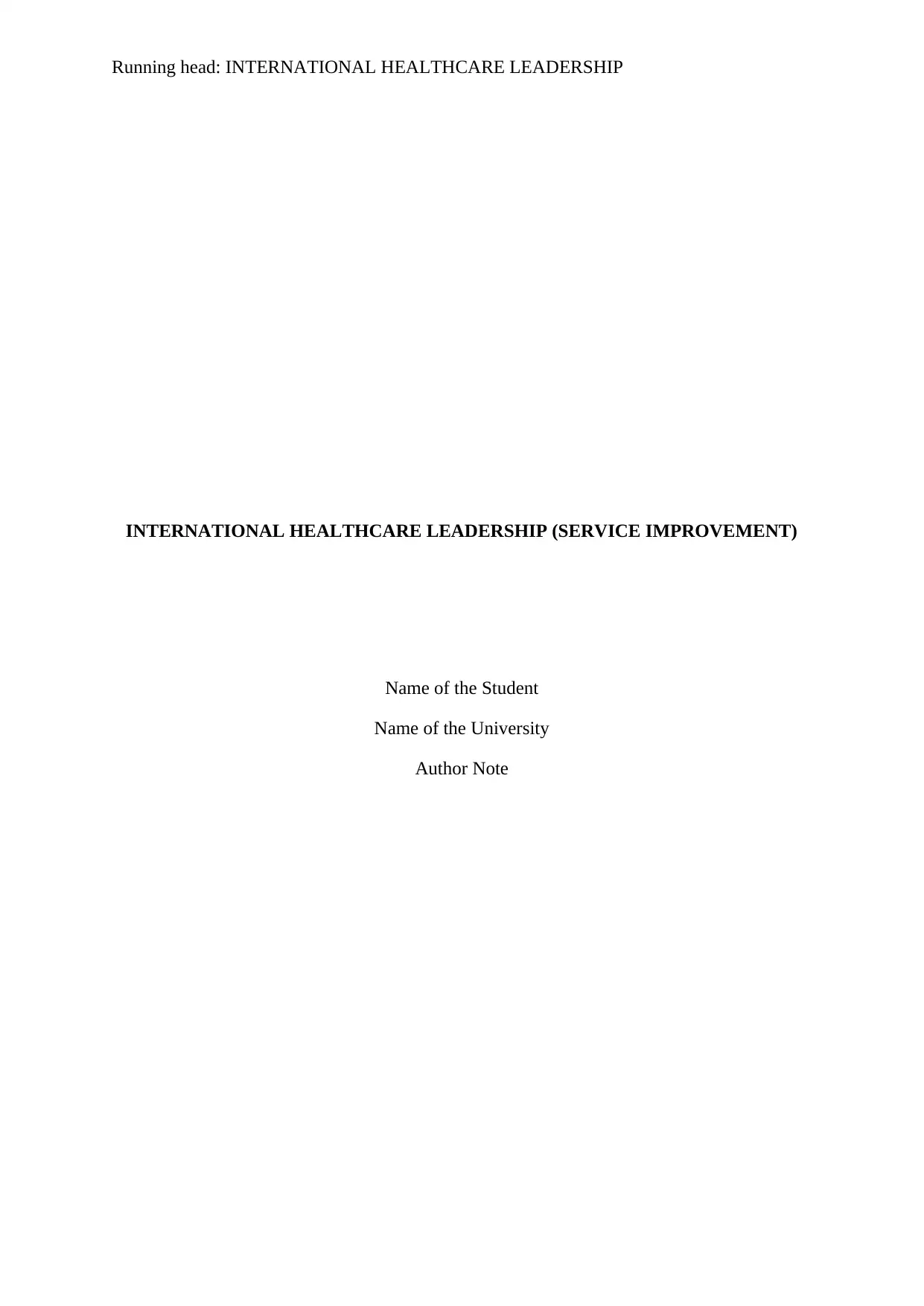
Running head: INTERNATIONAL HEALTHCARE LEADERSHIP
INTERNATIONAL HEALTHCARE LEADERSHIP (SERVICE IMPROVEMENT)
Name of the Student
Name of the University
Author Note
INTERNATIONAL HEALTHCARE LEADERSHIP (SERVICE IMPROVEMENT)
Name of the Student
Name of the University
Author Note
Paraphrase This Document
Need a fresh take? Get an instant paraphrase of this document with our AI Paraphraser
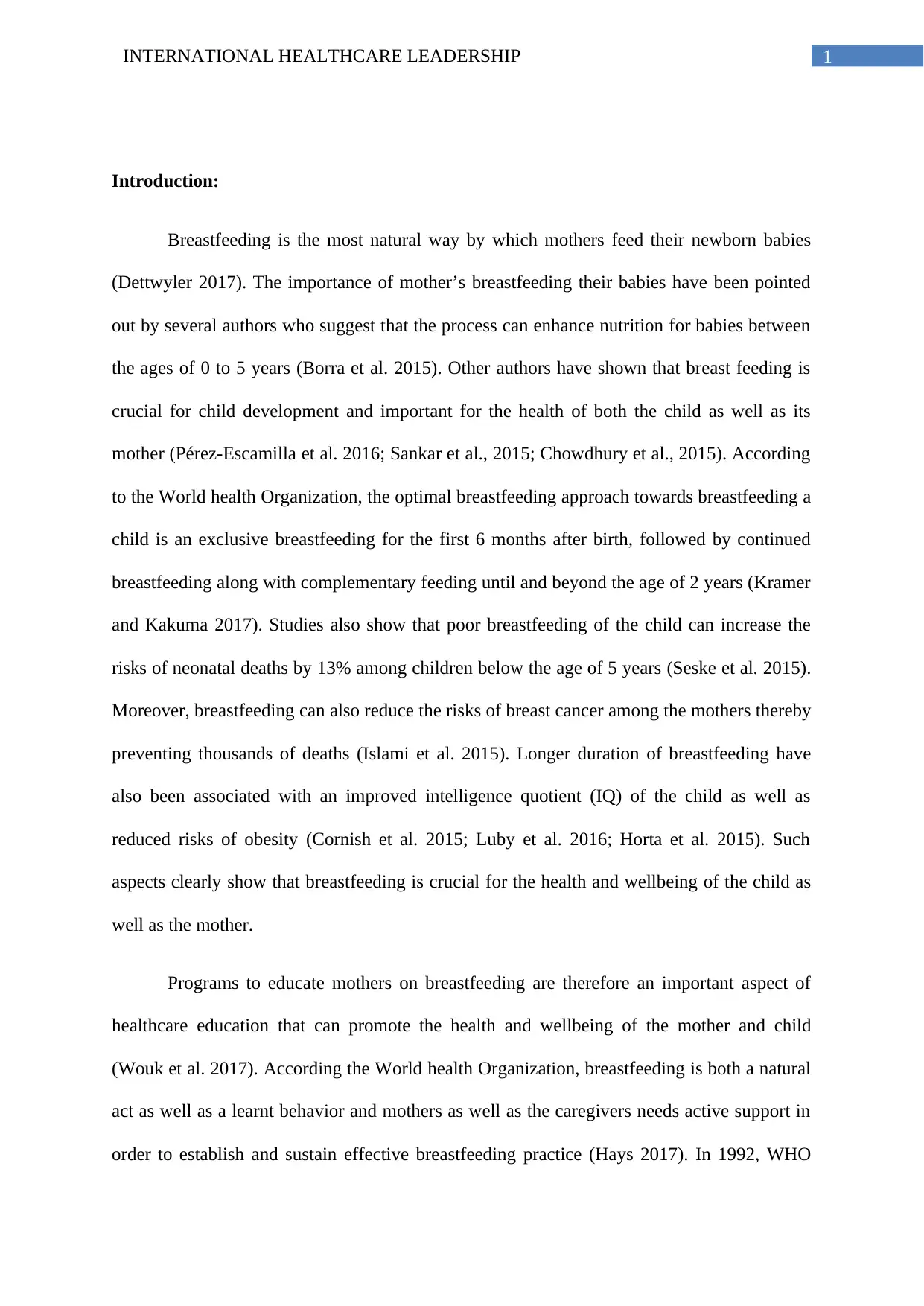
1INTERNATIONAL HEALTHCARE LEADERSHIP
Introduction:
Breastfeeding is the most natural way by which mothers feed their newborn babies
(Dettwyler 2017). The importance of mother’s breastfeeding their babies have been pointed
out by several authors who suggest that the process can enhance nutrition for babies between
the ages of 0 to 5 years (Borra et al. 2015). Other authors have shown that breast feeding is
crucial for child development and important for the health of both the child as well as its
mother (Pérez‐Escamilla et al. 2016; Sankar et al., 2015; Chowdhury et al., 2015). According
to the World health Organization, the optimal breastfeeding approach towards breastfeeding a
child is an exclusive breastfeeding for the first 6 months after birth, followed by continued
breastfeeding along with complementary feeding until and beyond the age of 2 years (Kramer
and Kakuma 2017). Studies also show that poor breastfeeding of the child can increase the
risks of neonatal deaths by 13% among children below the age of 5 years (Seske et al. 2015).
Moreover, breastfeeding can also reduce the risks of breast cancer among the mothers thereby
preventing thousands of deaths (Islami et al. 2015). Longer duration of breastfeeding have
also been associated with an improved intelligence quotient (IQ) of the child as well as
reduced risks of obesity (Cornish et al. 2015; Luby et al. 2016; Horta et al. 2015). Such
aspects clearly show that breastfeeding is crucial for the health and wellbeing of the child as
well as the mother.
Programs to educate mothers on breastfeeding are therefore an important aspect of
healthcare education that can promote the health and wellbeing of the mother and child
(Wouk et al. 2017). According the World health Organization, breastfeeding is both a natural
act as well as a learnt behavior and mothers as well as the caregivers needs active support in
order to establish and sustain effective breastfeeding practice (Hays 2017). In 1992, WHO
Introduction:
Breastfeeding is the most natural way by which mothers feed their newborn babies
(Dettwyler 2017). The importance of mother’s breastfeeding their babies have been pointed
out by several authors who suggest that the process can enhance nutrition for babies between
the ages of 0 to 5 years (Borra et al. 2015). Other authors have shown that breast feeding is
crucial for child development and important for the health of both the child as well as its
mother (Pérez‐Escamilla et al. 2016; Sankar et al., 2015; Chowdhury et al., 2015). According
to the World health Organization, the optimal breastfeeding approach towards breastfeeding a
child is an exclusive breastfeeding for the first 6 months after birth, followed by continued
breastfeeding along with complementary feeding until and beyond the age of 2 years (Kramer
and Kakuma 2017). Studies also show that poor breastfeeding of the child can increase the
risks of neonatal deaths by 13% among children below the age of 5 years (Seske et al. 2015).
Moreover, breastfeeding can also reduce the risks of breast cancer among the mothers thereby
preventing thousands of deaths (Islami et al. 2015). Longer duration of breastfeeding have
also been associated with an improved intelligence quotient (IQ) of the child as well as
reduced risks of obesity (Cornish et al. 2015; Luby et al. 2016; Horta et al. 2015). Such
aspects clearly show that breastfeeding is crucial for the health and wellbeing of the child as
well as the mother.
Programs to educate mothers on breastfeeding are therefore an important aspect of
healthcare education that can promote the health and wellbeing of the mother and child
(Wouk et al. 2017). According the World health Organization, breastfeeding is both a natural
act as well as a learnt behavior and mothers as well as the caregivers needs active support in
order to establish and sustain effective breastfeeding practice (Hays 2017). In 1992, WHO
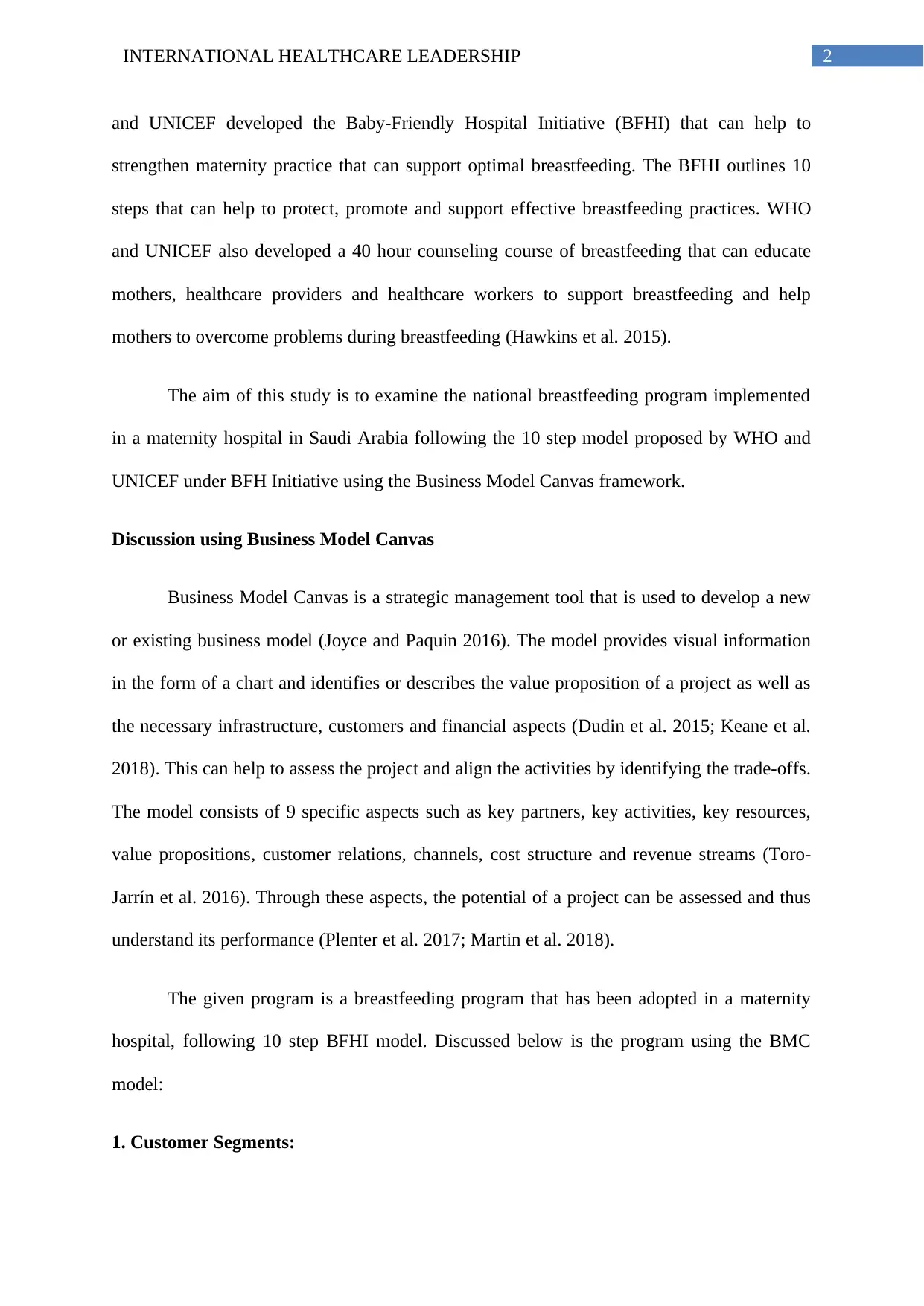
2INTERNATIONAL HEALTHCARE LEADERSHIP
and UNICEF developed the Baby-Friendly Hospital Initiative (BFHI) that can help to
strengthen maternity practice that can support optimal breastfeeding. The BFHI outlines 10
steps that can help to protect, promote and support effective breastfeeding practices. WHO
and UNICEF also developed a 40 hour counseling course of breastfeeding that can educate
mothers, healthcare providers and healthcare workers to support breastfeeding and help
mothers to overcome problems during breastfeeding (Hawkins et al. 2015).
The aim of this study is to examine the national breastfeeding program implemented
in a maternity hospital in Saudi Arabia following the 10 step model proposed by WHO and
UNICEF under BFH Initiative using the Business Model Canvas framework.
Discussion using Business Model Canvas
Business Model Canvas is a strategic management tool that is used to develop a new
or existing business model (Joyce and Paquin 2016). The model provides visual information
in the form of a chart and identifies or describes the value proposition of a project as well as
the necessary infrastructure, customers and financial aspects (Dudin et al. 2015; Keane et al.
2018). This can help to assess the project and align the activities by identifying the trade-offs.
The model consists of 9 specific aspects such as key partners, key activities, key resources,
value propositions, customer relations, channels, cost structure and revenue streams (Toro-
Jarrín et al. 2016). Through these aspects, the potential of a project can be assessed and thus
understand its performance (Plenter et al. 2017; Martin et al. 2018).
The given program is a breastfeeding program that has been adopted in a maternity
hospital, following 10 step BFHI model. Discussed below is the program using the BMC
model:
1. Customer Segments:
and UNICEF developed the Baby-Friendly Hospital Initiative (BFHI) that can help to
strengthen maternity practice that can support optimal breastfeeding. The BFHI outlines 10
steps that can help to protect, promote and support effective breastfeeding practices. WHO
and UNICEF also developed a 40 hour counseling course of breastfeeding that can educate
mothers, healthcare providers and healthcare workers to support breastfeeding and help
mothers to overcome problems during breastfeeding (Hawkins et al. 2015).
The aim of this study is to examine the national breastfeeding program implemented
in a maternity hospital in Saudi Arabia following the 10 step model proposed by WHO and
UNICEF under BFH Initiative using the Business Model Canvas framework.
Discussion using Business Model Canvas
Business Model Canvas is a strategic management tool that is used to develop a new
or existing business model (Joyce and Paquin 2016). The model provides visual information
in the form of a chart and identifies or describes the value proposition of a project as well as
the necessary infrastructure, customers and financial aspects (Dudin et al. 2015; Keane et al.
2018). This can help to assess the project and align the activities by identifying the trade-offs.
The model consists of 9 specific aspects such as key partners, key activities, key resources,
value propositions, customer relations, channels, cost structure and revenue streams (Toro-
Jarrín et al. 2016). Through these aspects, the potential of a project can be assessed and thus
understand its performance (Plenter et al. 2017; Martin et al. 2018).
The given program is a breastfeeding program that has been adopted in a maternity
hospital, following 10 step BFHI model. Discussed below is the program using the BMC
model:
1. Customer Segments:
⊘ This is a preview!⊘
Do you want full access?
Subscribe today to unlock all pages.

Trusted by 1+ million students worldwide
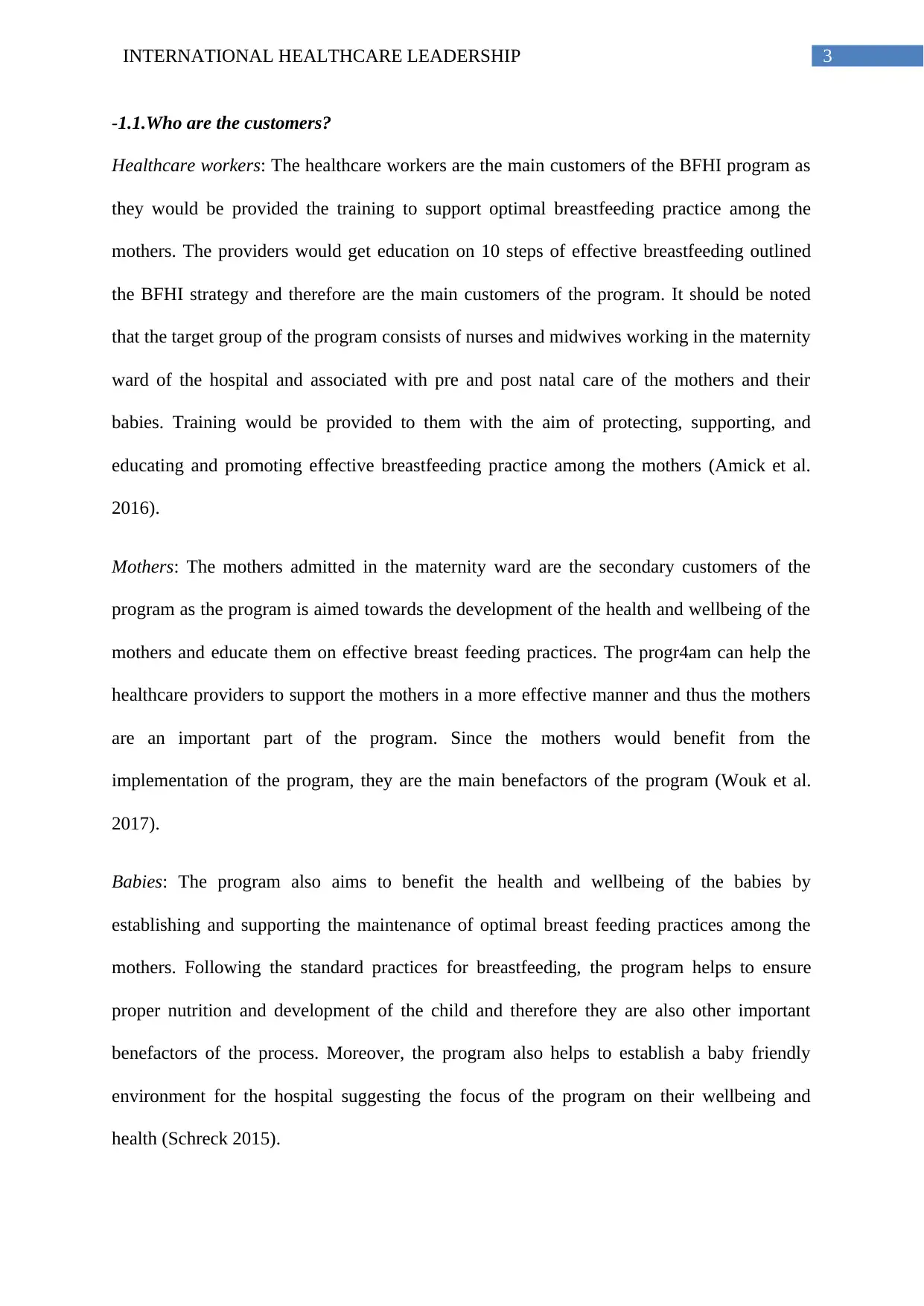
3INTERNATIONAL HEALTHCARE LEADERSHIP
-1.1.Who are the customers?
Healthcare workers: The healthcare workers are the main customers of the BFHI program as
they would be provided the training to support optimal breastfeeding practice among the
mothers. The providers would get education on 10 steps of effective breastfeeding outlined
the BFHI strategy and therefore are the main customers of the program. It should be noted
that the target group of the program consists of nurses and midwives working in the maternity
ward of the hospital and associated with pre and post natal care of the mothers and their
babies. Training would be provided to them with the aim of protecting, supporting, and
educating and promoting effective breastfeeding practice among the mothers (Amick et al.
2016).
Mothers: The mothers admitted in the maternity ward are the secondary customers of the
program as the program is aimed towards the development of the health and wellbeing of the
mothers and educate them on effective breast feeding practices. The progr4am can help the
healthcare providers to support the mothers in a more effective manner and thus the mothers
are an important part of the program. Since the mothers would benefit from the
implementation of the program, they are the main benefactors of the program (Wouk et al.
2017).
Babies: The program also aims to benefit the health and wellbeing of the babies by
establishing and supporting the maintenance of optimal breast feeding practices among the
mothers. Following the standard practices for breastfeeding, the program helps to ensure
proper nutrition and development of the child and therefore they are also other important
benefactors of the process. Moreover, the program also helps to establish a baby friendly
environment for the hospital suggesting the focus of the program on their wellbeing and
health (Schreck 2015).
-1.1.Who are the customers?
Healthcare workers: The healthcare workers are the main customers of the BFHI program as
they would be provided the training to support optimal breastfeeding practice among the
mothers. The providers would get education on 10 steps of effective breastfeeding outlined
the BFHI strategy and therefore are the main customers of the program. It should be noted
that the target group of the program consists of nurses and midwives working in the maternity
ward of the hospital and associated with pre and post natal care of the mothers and their
babies. Training would be provided to them with the aim of protecting, supporting, and
educating and promoting effective breastfeeding practice among the mothers (Amick et al.
2016).
Mothers: The mothers admitted in the maternity ward are the secondary customers of the
program as the program is aimed towards the development of the health and wellbeing of the
mothers and educate them on effective breast feeding practices. The progr4am can help the
healthcare providers to support the mothers in a more effective manner and thus the mothers
are an important part of the program. Since the mothers would benefit from the
implementation of the program, they are the main benefactors of the program (Wouk et al.
2017).
Babies: The program also aims to benefit the health and wellbeing of the babies by
establishing and supporting the maintenance of optimal breast feeding practices among the
mothers. Following the standard practices for breastfeeding, the program helps to ensure
proper nutrition and development of the child and therefore they are also other important
benefactors of the process. Moreover, the program also helps to establish a baby friendly
environment for the hospital suggesting the focus of the program on their wellbeing and
health (Schreck 2015).
Paraphrase This Document
Need a fresh take? Get an instant paraphrase of this document with our AI Paraphraser
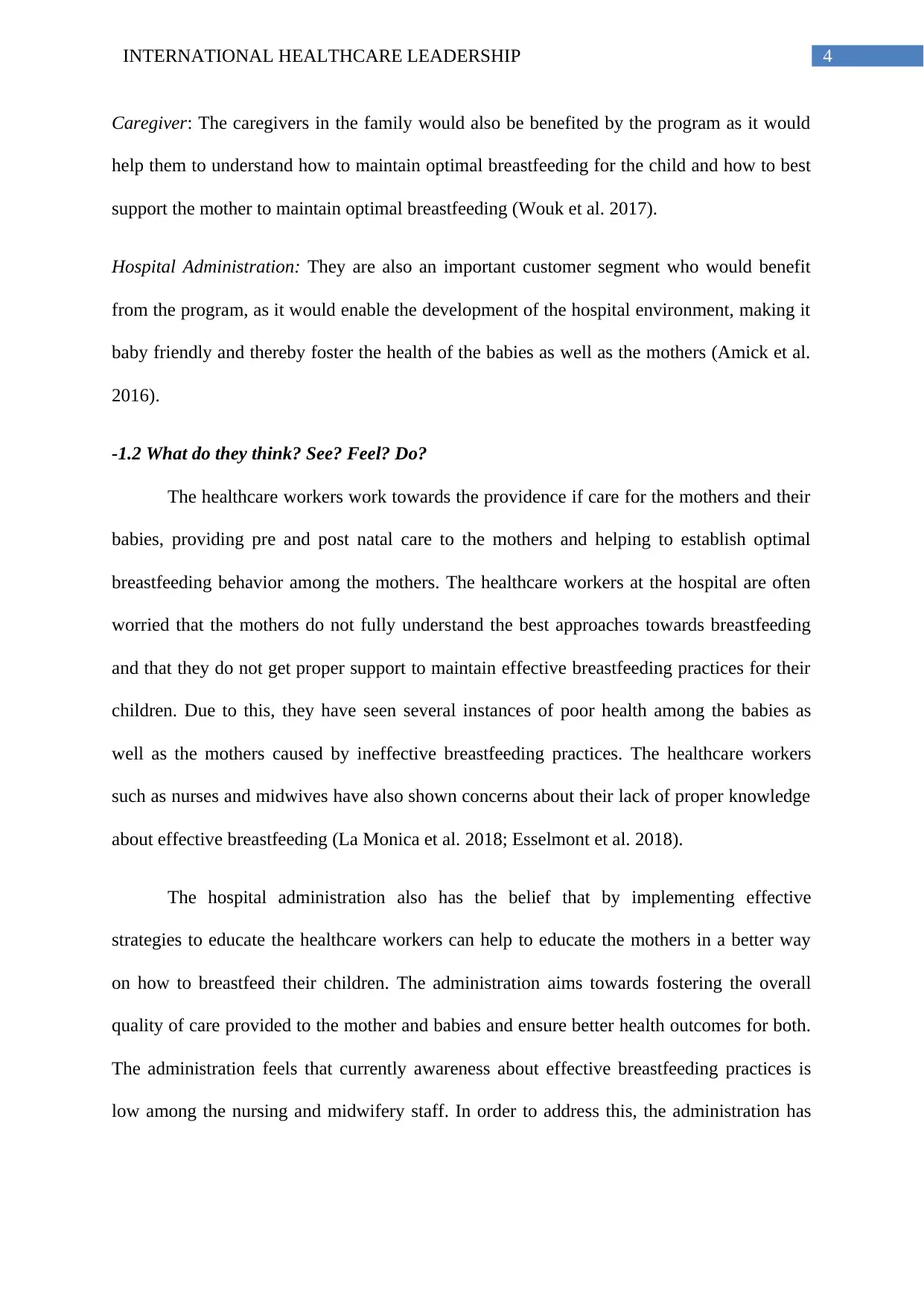
4INTERNATIONAL HEALTHCARE LEADERSHIP
Caregiver: The caregivers in the family would also be benefited by the program as it would
help them to understand how to maintain optimal breastfeeding for the child and how to best
support the mother to maintain optimal breastfeeding (Wouk et al. 2017).
Hospital Administration: They are also an important customer segment who would benefit
from the program, as it would enable the development of the hospital environment, making it
baby friendly and thereby foster the health of the babies as well as the mothers (Amick et al.
2016).
-1.2 What do they think? See? Feel? Do?
The healthcare workers work towards the providence if care for the mothers and their
babies, providing pre and post natal care to the mothers and helping to establish optimal
breastfeeding behavior among the mothers. The healthcare workers at the hospital are often
worried that the mothers do not fully understand the best approaches towards breastfeeding
and that they do not get proper support to maintain effective breastfeeding practices for their
children. Due to this, they have seen several instances of poor health among the babies as
well as the mothers caused by ineffective breastfeeding practices. The healthcare workers
such as nurses and midwives have also shown concerns about their lack of proper knowledge
about effective breastfeeding (La Monica et al. 2018; Esselmont et al. 2018).
The hospital administration also has the belief that by implementing effective
strategies to educate the healthcare workers can help to educate the mothers in a better way
on how to breastfeed their children. The administration aims towards fostering the overall
quality of care provided to the mother and babies and ensure better health outcomes for both.
The administration feels that currently awareness about effective breastfeeding practices is
low among the nursing and midwifery staff. In order to address this, the administration has
Caregiver: The caregivers in the family would also be benefited by the program as it would
help them to understand how to maintain optimal breastfeeding for the child and how to best
support the mother to maintain optimal breastfeeding (Wouk et al. 2017).
Hospital Administration: They are also an important customer segment who would benefit
from the program, as it would enable the development of the hospital environment, making it
baby friendly and thereby foster the health of the babies as well as the mothers (Amick et al.
2016).
-1.2 What do they think? See? Feel? Do?
The healthcare workers work towards the providence if care for the mothers and their
babies, providing pre and post natal care to the mothers and helping to establish optimal
breastfeeding behavior among the mothers. The healthcare workers at the hospital are often
worried that the mothers do not fully understand the best approaches towards breastfeeding
and that they do not get proper support to maintain effective breastfeeding practices for their
children. Due to this, they have seen several instances of poor health among the babies as
well as the mothers caused by ineffective breastfeeding practices. The healthcare workers
such as nurses and midwives have also shown concerns about their lack of proper knowledge
about effective breastfeeding (La Monica et al. 2018; Esselmont et al. 2018).
The hospital administration also has the belief that by implementing effective
strategies to educate the healthcare workers can help to educate the mothers in a better way
on how to breastfeed their children. The administration aims towards fostering the overall
quality of care provided to the mother and babies and ensure better health outcomes for both.
The administration feels that currently awareness about effective breastfeeding practices is
low among the nursing and midwifery staff. In order to address this, the administration has
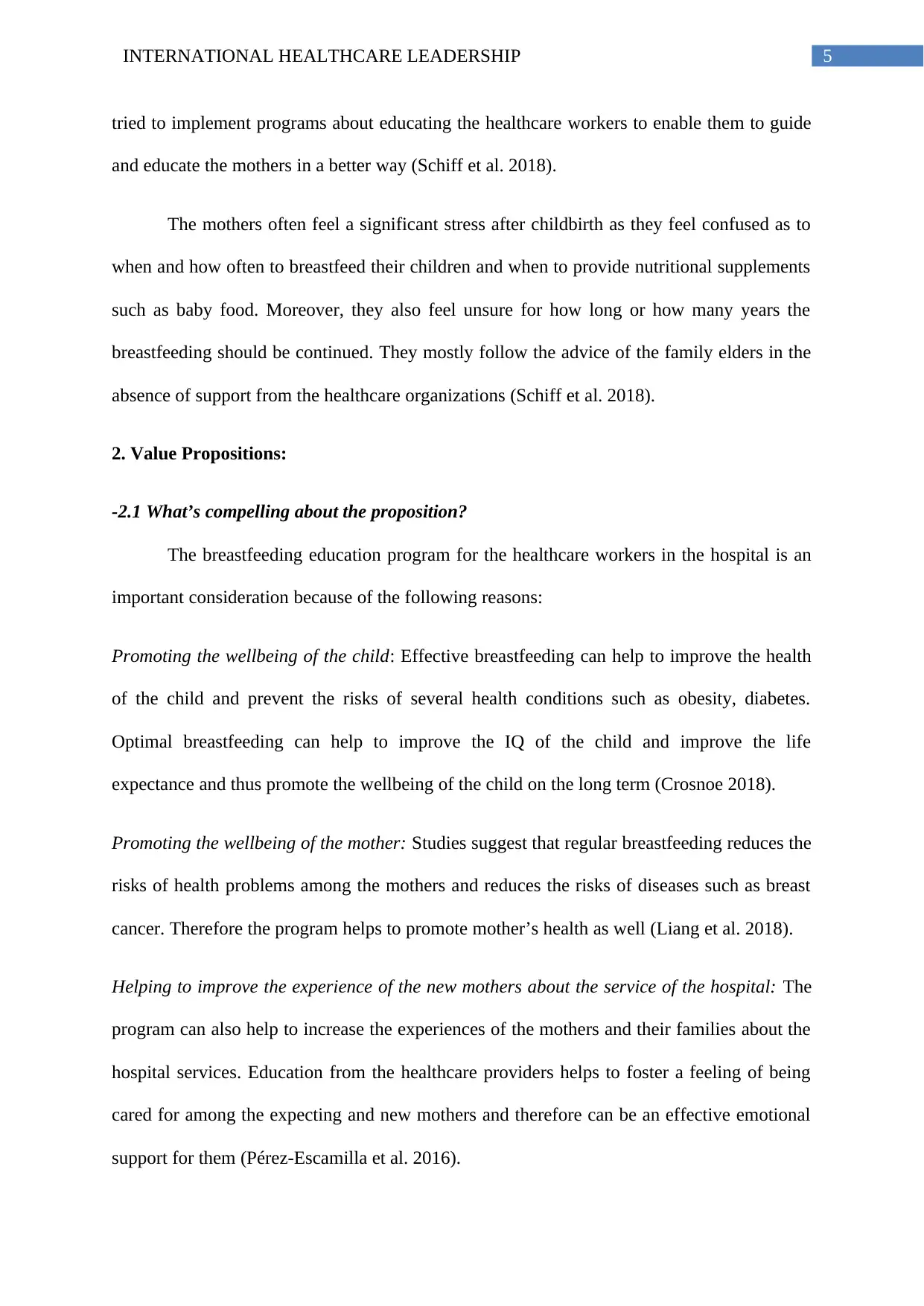
5INTERNATIONAL HEALTHCARE LEADERSHIP
tried to implement programs about educating the healthcare workers to enable them to guide
and educate the mothers in a better way (Schiff et al. 2018).
The mothers often feel a significant stress after childbirth as they feel confused as to
when and how often to breastfeed their children and when to provide nutritional supplements
such as baby food. Moreover, they also feel unsure for how long or how many years the
breastfeeding should be continued. They mostly follow the advice of the family elders in the
absence of support from the healthcare organizations (Schiff et al. 2018).
2. Value Propositions:
-2.1 What’s compelling about the proposition?
The breastfeeding education program for the healthcare workers in the hospital is an
important consideration because of the following reasons:
Promoting the wellbeing of the child: Effective breastfeeding can help to improve the health
of the child and prevent the risks of several health conditions such as obesity, diabetes.
Optimal breastfeeding can help to improve the IQ of the child and improve the life
expectance and thus promote the wellbeing of the child on the long term (Crosnoe 2018).
Promoting the wellbeing of the mother: Studies suggest that regular breastfeeding reduces the
risks of health problems among the mothers and reduces the risks of diseases such as breast
cancer. Therefore the program helps to promote mother’s health as well (Liang et al. 2018).
Helping to improve the experience of the new mothers about the service of the hospital: The
program can also help to increase the experiences of the mothers and their families about the
hospital services. Education from the healthcare providers helps to foster a feeling of being
cared for among the expecting and new mothers and therefore can be an effective emotional
support for them (Pérez‐Escamilla et al. 2016).
tried to implement programs about educating the healthcare workers to enable them to guide
and educate the mothers in a better way (Schiff et al. 2018).
The mothers often feel a significant stress after childbirth as they feel confused as to
when and how often to breastfeed their children and when to provide nutritional supplements
such as baby food. Moreover, they also feel unsure for how long or how many years the
breastfeeding should be continued. They mostly follow the advice of the family elders in the
absence of support from the healthcare organizations (Schiff et al. 2018).
2. Value Propositions:
-2.1 What’s compelling about the proposition?
The breastfeeding education program for the healthcare workers in the hospital is an
important consideration because of the following reasons:
Promoting the wellbeing of the child: Effective breastfeeding can help to improve the health
of the child and prevent the risks of several health conditions such as obesity, diabetes.
Optimal breastfeeding can help to improve the IQ of the child and improve the life
expectance and thus promote the wellbeing of the child on the long term (Crosnoe 2018).
Promoting the wellbeing of the mother: Studies suggest that regular breastfeeding reduces the
risks of health problems among the mothers and reduces the risks of diseases such as breast
cancer. Therefore the program helps to promote mother’s health as well (Liang et al. 2018).
Helping to improve the experience of the new mothers about the service of the hospital: The
program can also help to increase the experiences of the mothers and their families about the
hospital services. Education from the healthcare providers helps to foster a feeling of being
cared for among the expecting and new mothers and therefore can be an effective emotional
support for them (Pérez‐Escamilla et al. 2016).
⊘ This is a preview!⊘
Do you want full access?
Subscribe today to unlock all pages.

Trusted by 1+ million students worldwide
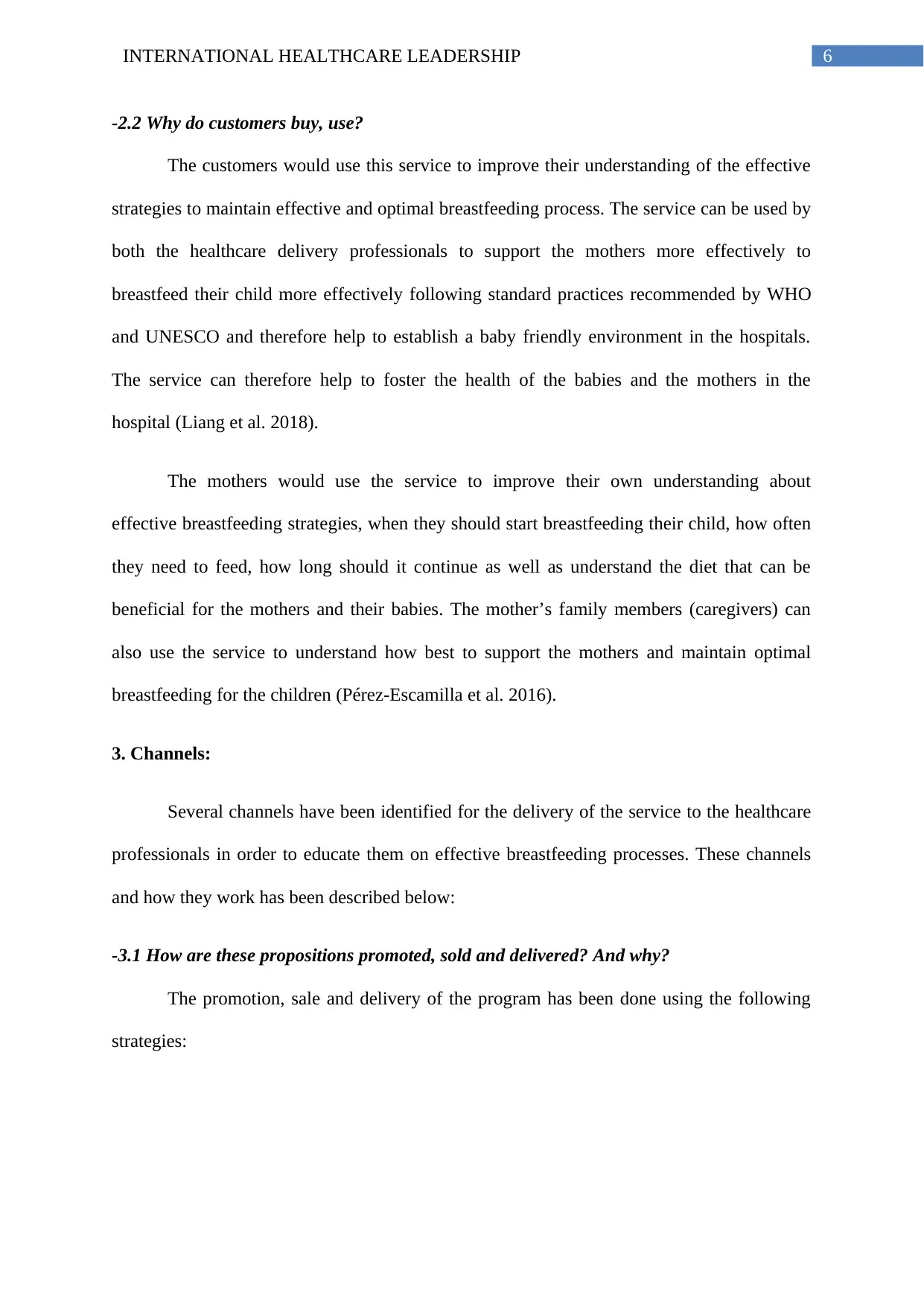
6INTERNATIONAL HEALTHCARE LEADERSHIP
-2.2 Why do customers buy, use?
The customers would use this service to improve their understanding of the effective
strategies to maintain effective and optimal breastfeeding process. The service can be used by
both the healthcare delivery professionals to support the mothers more effectively to
breastfeed their child more effectively following standard practices recommended by WHO
and UNESCO and therefore help to establish a baby friendly environment in the hospitals.
The service can therefore help to foster the health of the babies and the mothers in the
hospital (Liang et al. 2018).
The mothers would use the service to improve their own understanding about
effective breastfeeding strategies, when they should start breastfeeding their child, how often
they need to feed, how long should it continue as well as understand the diet that can be
beneficial for the mothers and their babies. The mother’s family members (caregivers) can
also use the service to understand how best to support the mothers and maintain optimal
breastfeeding for the children (Pérez‐Escamilla et al. 2016).
3. Channels:
Several channels have been identified for the delivery of the service to the healthcare
professionals in order to educate them on effective breastfeeding processes. These channels
and how they work has been described below:
-3.1 How are these propositions promoted, sold and delivered? And why?
The promotion, sale and delivery of the program has been done using the following
strategies:
-2.2 Why do customers buy, use?
The customers would use this service to improve their understanding of the effective
strategies to maintain effective and optimal breastfeeding process. The service can be used by
both the healthcare delivery professionals to support the mothers more effectively to
breastfeed their child more effectively following standard practices recommended by WHO
and UNESCO and therefore help to establish a baby friendly environment in the hospitals.
The service can therefore help to foster the health of the babies and the mothers in the
hospital (Liang et al. 2018).
The mothers would use the service to improve their own understanding about
effective breastfeeding strategies, when they should start breastfeeding their child, how often
they need to feed, how long should it continue as well as understand the diet that can be
beneficial for the mothers and their babies. The mother’s family members (caregivers) can
also use the service to understand how best to support the mothers and maintain optimal
breastfeeding for the children (Pérez‐Escamilla et al. 2016).
3. Channels:
Several channels have been identified for the delivery of the service to the healthcare
professionals in order to educate them on effective breastfeeding processes. These channels
and how they work has been described below:
-3.1 How are these propositions promoted, sold and delivered? And why?
The promotion, sale and delivery of the program has been done using the following
strategies:
Paraphrase This Document
Need a fresh take? Get an instant paraphrase of this document with our AI Paraphraser
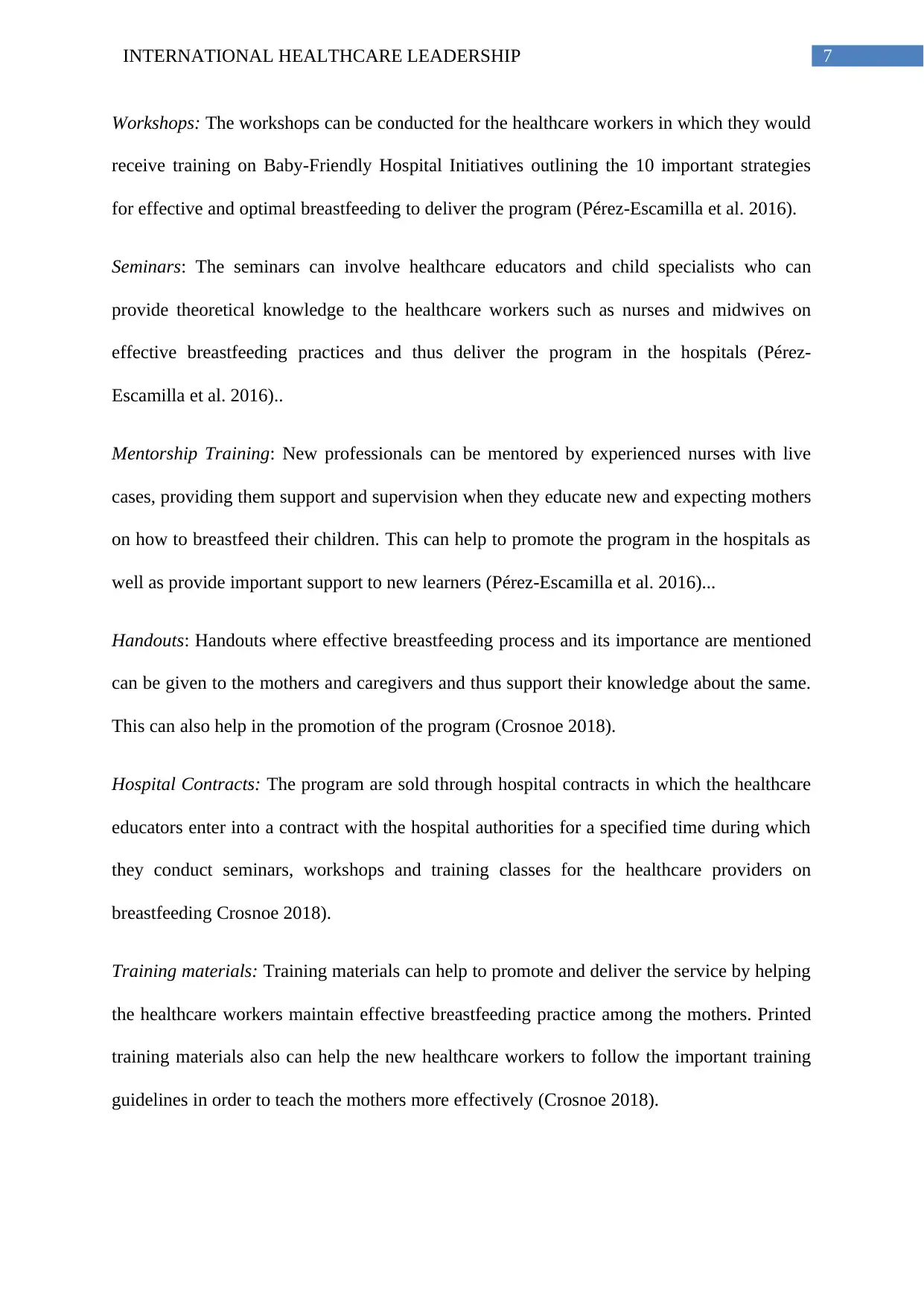
7INTERNATIONAL HEALTHCARE LEADERSHIP
Workshops: The workshops can be conducted for the healthcare workers in which they would
receive training on Baby-Friendly Hospital Initiatives outlining the 10 important strategies
for effective and optimal breastfeeding to deliver the program (Pérez‐Escamilla et al. 2016).
Seminars: The seminars can involve healthcare educators and child specialists who can
provide theoretical knowledge to the healthcare workers such as nurses and midwives on
effective breastfeeding practices and thus deliver the program in the hospitals (Pérez‐
Escamilla et al. 2016)..
Mentorship Training: New professionals can be mentored by experienced nurses with live
cases, providing them support and supervision when they educate new and expecting mothers
on how to breastfeed their children. This can help to promote the program in the hospitals as
well as provide important support to new learners (Pérez‐Escamilla et al. 2016)...
Handouts: Handouts where effective breastfeeding process and its importance are mentioned
can be given to the mothers and caregivers and thus support their knowledge about the same.
This can also help in the promotion of the program (Crosnoe 2018).
Hospital Contracts: The program are sold through hospital contracts in which the healthcare
educators enter into a contract with the hospital authorities for a specified time during which
they conduct seminars, workshops and training classes for the healthcare providers on
breastfeeding Crosnoe 2018).
Training materials: Training materials can help to promote and deliver the service by helping
the healthcare workers maintain effective breastfeeding practice among the mothers. Printed
training materials also can help the new healthcare workers to follow the important training
guidelines in order to teach the mothers more effectively (Crosnoe 2018).
Workshops: The workshops can be conducted for the healthcare workers in which they would
receive training on Baby-Friendly Hospital Initiatives outlining the 10 important strategies
for effective and optimal breastfeeding to deliver the program (Pérez‐Escamilla et al. 2016).
Seminars: The seminars can involve healthcare educators and child specialists who can
provide theoretical knowledge to the healthcare workers such as nurses and midwives on
effective breastfeeding practices and thus deliver the program in the hospitals (Pérez‐
Escamilla et al. 2016)..
Mentorship Training: New professionals can be mentored by experienced nurses with live
cases, providing them support and supervision when they educate new and expecting mothers
on how to breastfeed their children. This can help to promote the program in the hospitals as
well as provide important support to new learners (Pérez‐Escamilla et al. 2016)...
Handouts: Handouts where effective breastfeeding process and its importance are mentioned
can be given to the mothers and caregivers and thus support their knowledge about the same.
This can also help in the promotion of the program (Crosnoe 2018).
Hospital Contracts: The program are sold through hospital contracts in which the healthcare
educators enter into a contract with the hospital authorities for a specified time during which
they conduct seminars, workshops and training classes for the healthcare providers on
breastfeeding Crosnoe 2018).
Training materials: Training materials can help to promote and deliver the service by helping
the healthcare workers maintain effective breastfeeding practice among the mothers. Printed
training materials also can help the new healthcare workers to follow the important training
guidelines in order to teach the mothers more effectively (Crosnoe 2018).
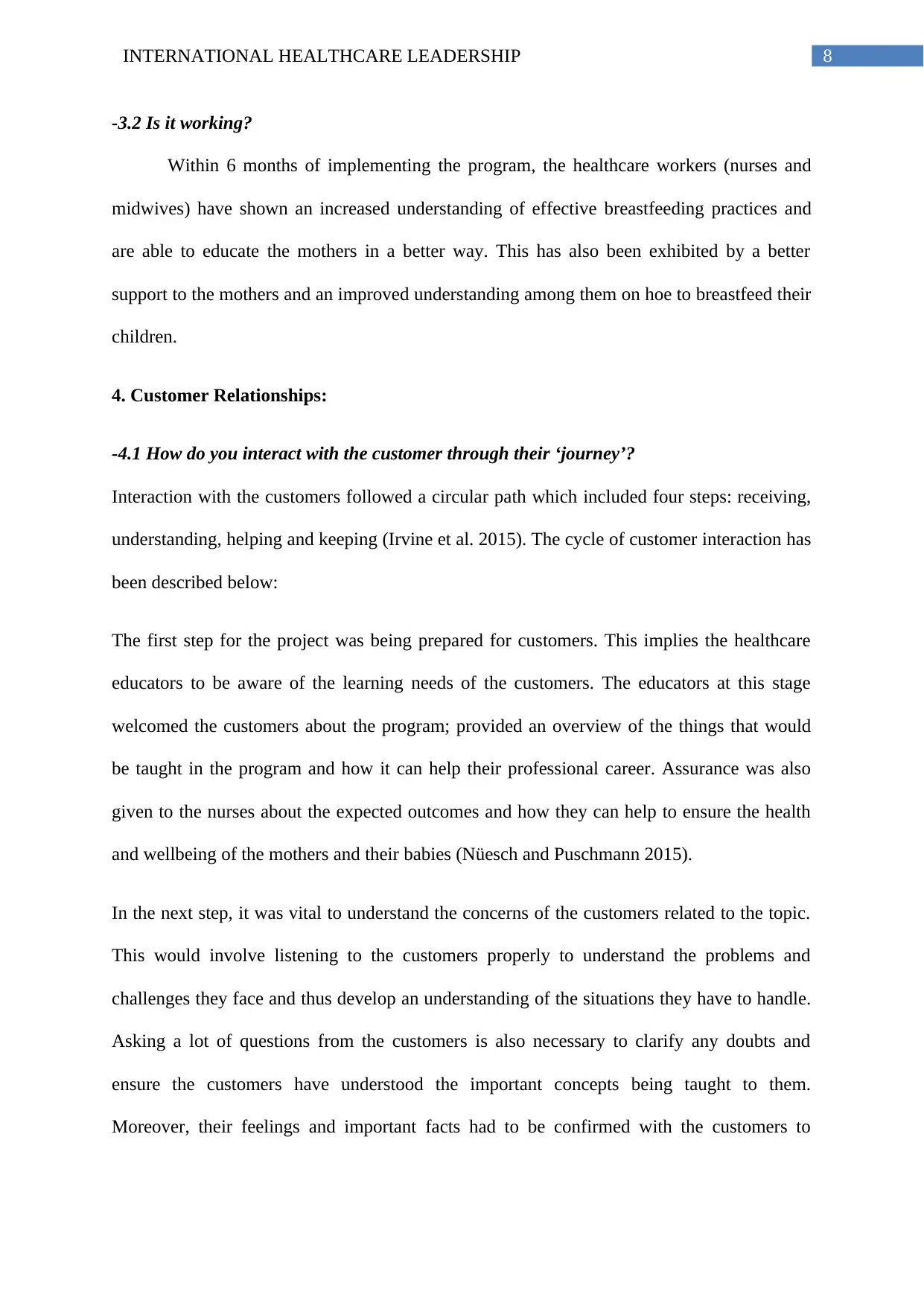
8INTERNATIONAL HEALTHCARE LEADERSHIP
-3.2 Is it working?
Within 6 months of implementing the program, the healthcare workers (nurses and
midwives) have shown an increased understanding of effective breastfeeding practices and
are able to educate the mothers in a better way. This has also been exhibited by a better
support to the mothers and an improved understanding among them on hoe to breastfeed their
children.
4. Customer Relationships:
-4.1 How do you interact with the customer through their ‘journey’?
Interaction with the customers followed a circular path which included four steps: receiving,
understanding, helping and keeping (Irvine et al. 2015). The cycle of customer interaction has
been described below:
The first step for the project was being prepared for customers. This implies the healthcare
educators to be aware of the learning needs of the customers. The educators at this stage
welcomed the customers about the program; provided an overview of the things that would
be taught in the program and how it can help their professional career. Assurance was also
given to the nurses about the expected outcomes and how they can help to ensure the health
and wellbeing of the mothers and their babies (Nüesch and Puschmann 2015).
In the next step, it was vital to understand the concerns of the customers related to the topic.
This would involve listening to the customers properly to understand the problems and
challenges they face and thus develop an understanding of the situations they have to handle.
Asking a lot of questions from the customers is also necessary to clarify any doubts and
ensure the customers have understood the important concepts being taught to them.
Moreover, their feelings and important facts had to be confirmed with the customers to
-3.2 Is it working?
Within 6 months of implementing the program, the healthcare workers (nurses and
midwives) have shown an increased understanding of effective breastfeeding practices and
are able to educate the mothers in a better way. This has also been exhibited by a better
support to the mothers and an improved understanding among them on hoe to breastfeed their
children.
4. Customer Relationships:
-4.1 How do you interact with the customer through their ‘journey’?
Interaction with the customers followed a circular path which included four steps: receiving,
understanding, helping and keeping (Irvine et al. 2015). The cycle of customer interaction has
been described below:
The first step for the project was being prepared for customers. This implies the healthcare
educators to be aware of the learning needs of the customers. The educators at this stage
welcomed the customers about the program; provided an overview of the things that would
be taught in the program and how it can help their professional career. Assurance was also
given to the nurses about the expected outcomes and how they can help to ensure the health
and wellbeing of the mothers and their babies (Nüesch and Puschmann 2015).
In the next step, it was vital to understand the concerns of the customers related to the topic.
This would involve listening to the customers properly to understand the problems and
challenges they face and thus develop an understanding of the situations they have to handle.
Asking a lot of questions from the customers is also necessary to clarify any doubts and
ensure the customers have understood the important concepts being taught to them.
Moreover, their feelings and important facts had to be confirmed with the customers to
⊘ This is a preview!⊘
Do you want full access?
Subscribe today to unlock all pages.

Trusted by 1+ million students worldwide
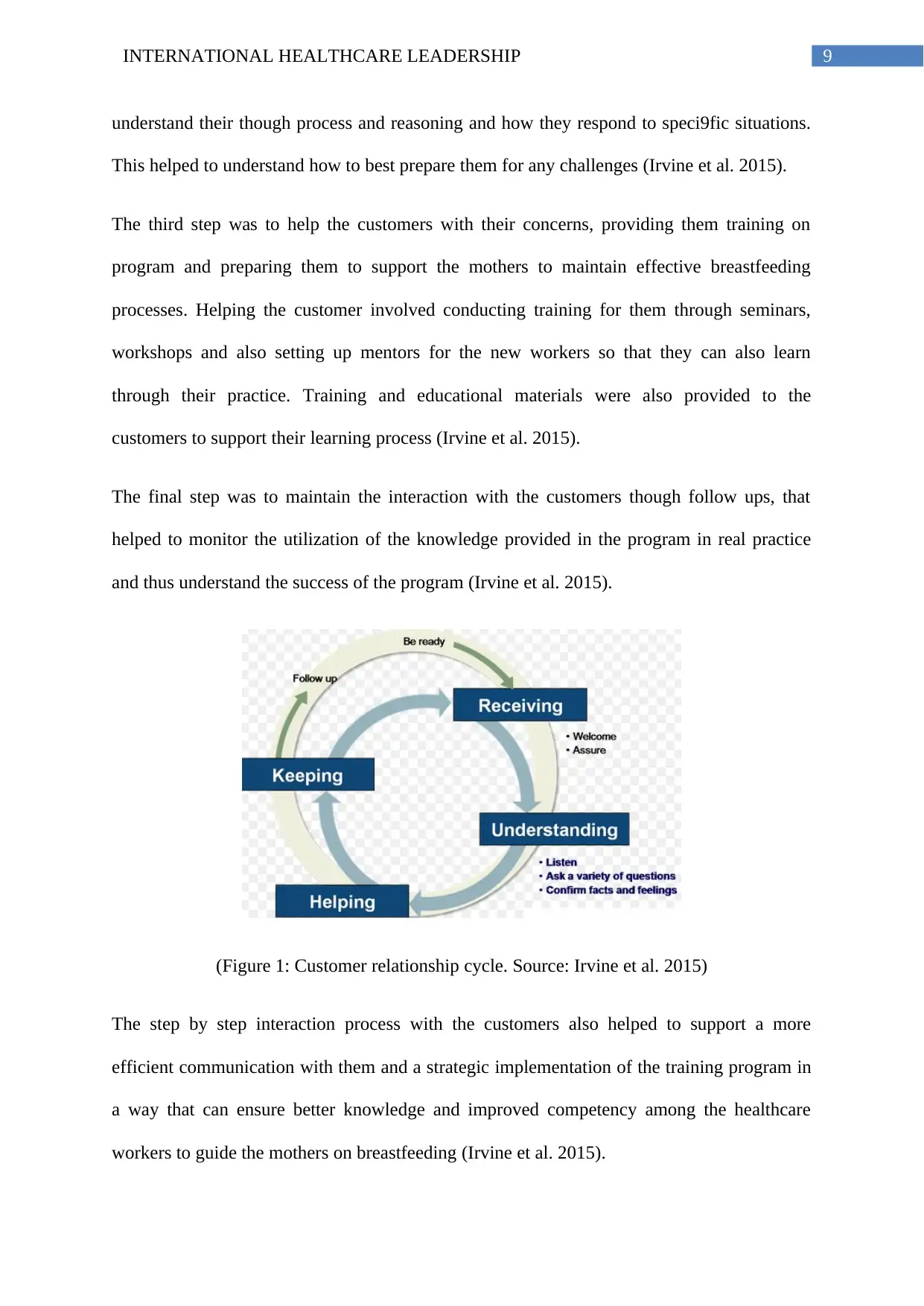
9INTERNATIONAL HEALTHCARE LEADERSHIP
understand their though process and reasoning and how they respond to speci9fic situations.
This helped to understand how to best prepare them for any challenges (Irvine et al. 2015).
The third step was to help the customers with their concerns, providing them training on
program and preparing them to support the mothers to maintain effective breastfeeding
processes. Helping the customer involved conducting training for them through seminars,
workshops and also setting up mentors for the new workers so that they can also learn
through their practice. Training and educational materials were also provided to the
customers to support their learning process (Irvine et al. 2015).
The final step was to maintain the interaction with the customers though follow ups, that
helped to monitor the utilization of the knowledge provided in the program in real practice
and thus understand the success of the program (Irvine et al. 2015).
(Figure 1: Customer relationship cycle. Source: Irvine et al. 2015)
The step by step interaction process with the customers also helped to support a more
efficient communication with them and a strategic implementation of the training program in
a way that can ensure better knowledge and improved competency among the healthcare
workers to guide the mothers on breastfeeding (Irvine et al. 2015).
understand their though process and reasoning and how they respond to speci9fic situations.
This helped to understand how to best prepare them for any challenges (Irvine et al. 2015).
The third step was to help the customers with their concerns, providing them training on
program and preparing them to support the mothers to maintain effective breastfeeding
processes. Helping the customer involved conducting training for them through seminars,
workshops and also setting up mentors for the new workers so that they can also learn
through their practice. Training and educational materials were also provided to the
customers to support their learning process (Irvine et al. 2015).
The final step was to maintain the interaction with the customers though follow ups, that
helped to monitor the utilization of the knowledge provided in the program in real practice
and thus understand the success of the program (Irvine et al. 2015).
(Figure 1: Customer relationship cycle. Source: Irvine et al. 2015)
The step by step interaction process with the customers also helped to support a more
efficient communication with them and a strategic implementation of the training program in
a way that can ensure better knowledge and improved competency among the healthcare
workers to guide the mothers on breastfeeding (Irvine et al. 2015).
Paraphrase This Document
Need a fresh take? Get an instant paraphrase of this document with our AI Paraphraser
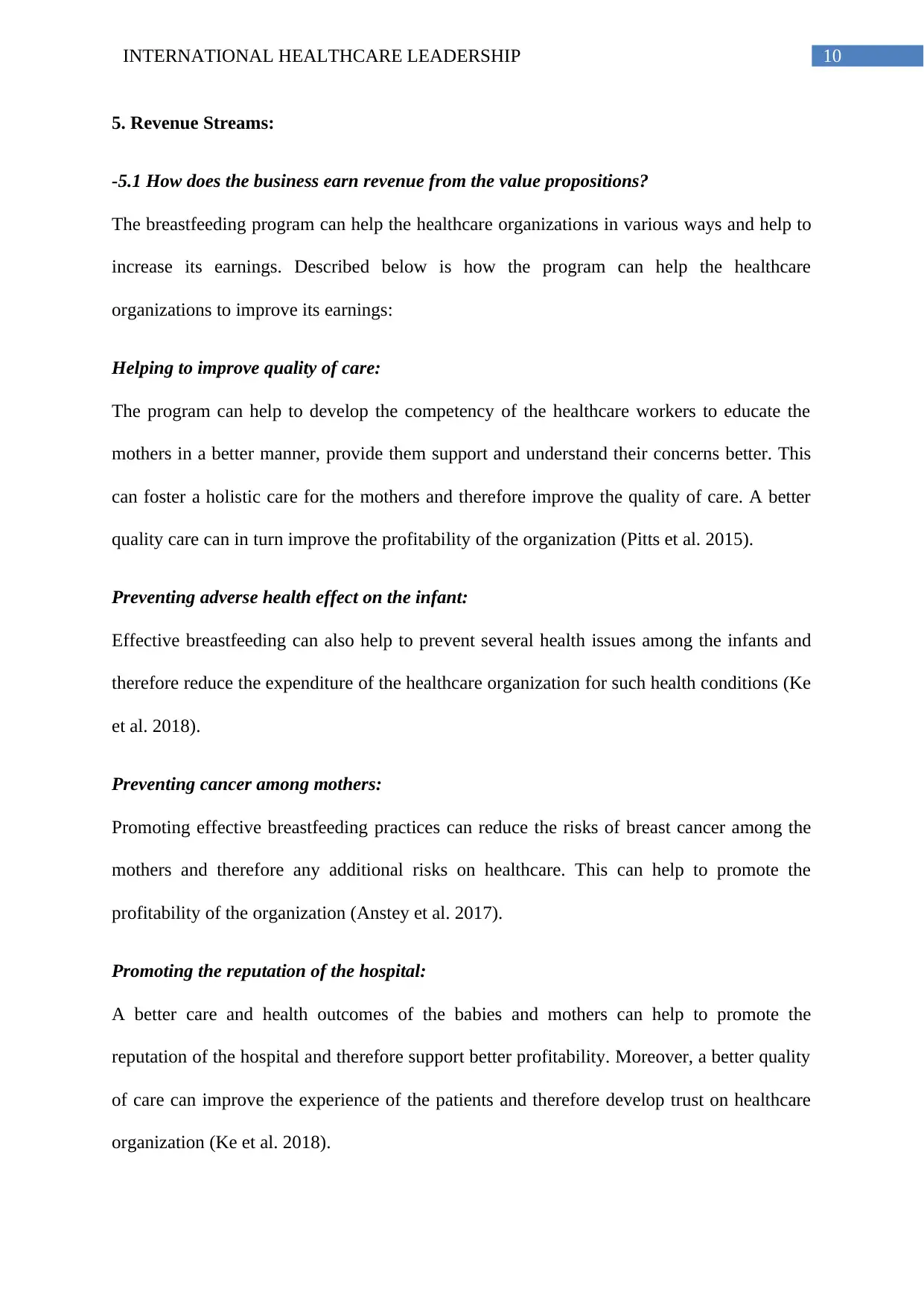
10INTERNATIONAL HEALTHCARE LEADERSHIP
5. Revenue Streams:
-5.1 How does the business earn revenue from the value propositions?
The breastfeeding program can help the healthcare organizations in various ways and help to
increase its earnings. Described below is how the program can help the healthcare
organizations to improve its earnings:
Helping to improve quality of care:
The program can help to develop the competency of the healthcare workers to educate the
mothers in a better manner, provide them support and understand their concerns better. This
can foster a holistic care for the mothers and therefore improve the quality of care. A better
quality care can in turn improve the profitability of the organization (Pitts et al. 2015).
Preventing adverse health effect on the infant:
Effective breastfeeding can also help to prevent several health issues among the infants and
therefore reduce the expenditure of the healthcare organization for such health conditions (Ke
et al. 2018).
Preventing cancer among mothers:
Promoting effective breastfeeding practices can reduce the risks of breast cancer among the
mothers and therefore any additional risks on healthcare. This can help to promote the
profitability of the organization (Anstey et al. 2017).
Promoting the reputation of the hospital:
A better care and health outcomes of the babies and mothers can help to promote the
reputation of the hospital and therefore support better profitability. Moreover, a better quality
of care can improve the experience of the patients and therefore develop trust on healthcare
organization (Ke et al. 2018).
5. Revenue Streams:
-5.1 How does the business earn revenue from the value propositions?
The breastfeeding program can help the healthcare organizations in various ways and help to
increase its earnings. Described below is how the program can help the healthcare
organizations to improve its earnings:
Helping to improve quality of care:
The program can help to develop the competency of the healthcare workers to educate the
mothers in a better manner, provide them support and understand their concerns better. This
can foster a holistic care for the mothers and therefore improve the quality of care. A better
quality care can in turn improve the profitability of the organization (Pitts et al. 2015).
Preventing adverse health effect on the infant:
Effective breastfeeding can also help to prevent several health issues among the infants and
therefore reduce the expenditure of the healthcare organization for such health conditions (Ke
et al. 2018).
Preventing cancer among mothers:
Promoting effective breastfeeding practices can reduce the risks of breast cancer among the
mothers and therefore any additional risks on healthcare. This can help to promote the
profitability of the organization (Anstey et al. 2017).
Promoting the reputation of the hospital:
A better care and health outcomes of the babies and mothers can help to promote the
reputation of the hospital and therefore support better profitability. Moreover, a better quality
of care can improve the experience of the patients and therefore develop trust on healthcare
organization (Ke et al. 2018).
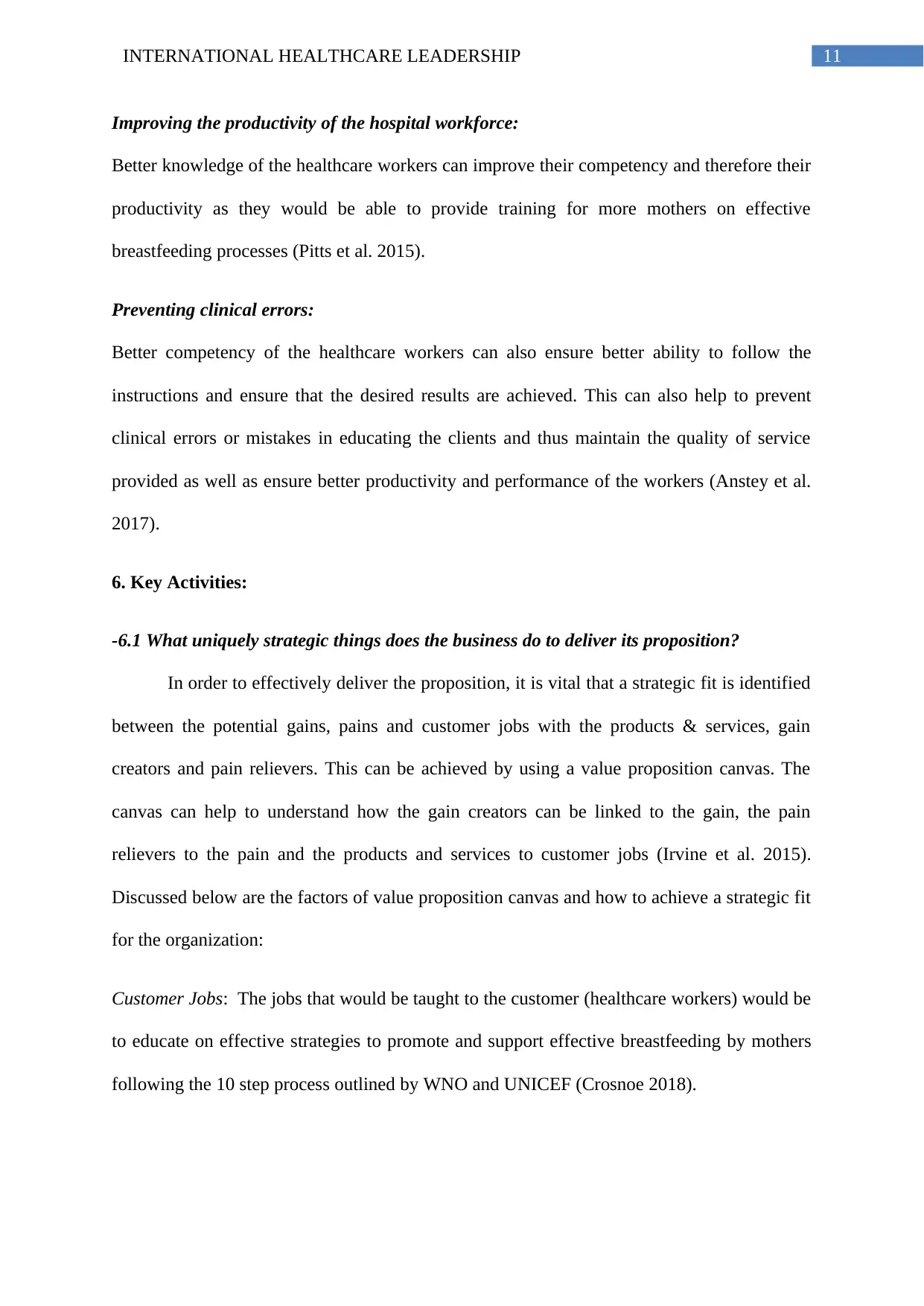
11INTERNATIONAL HEALTHCARE LEADERSHIP
Improving the productivity of the hospital workforce:
Better knowledge of the healthcare workers can improve their competency and therefore their
productivity as they would be able to provide training for more mothers on effective
breastfeeding processes (Pitts et al. 2015).
Preventing clinical errors:
Better competency of the healthcare workers can also ensure better ability to follow the
instructions and ensure that the desired results are achieved. This can also help to prevent
clinical errors or mistakes in educating the clients and thus maintain the quality of service
provided as well as ensure better productivity and performance of the workers (Anstey et al.
2017).
6. Key Activities:
-6.1 What uniquely strategic things does the business do to deliver its proposition?
In order to effectively deliver the proposition, it is vital that a strategic fit is identified
between the potential gains, pains and customer jobs with the products & services, gain
creators and pain relievers. This can be achieved by using a value proposition canvas. The
canvas can help to understand how the gain creators can be linked to the gain, the pain
relievers to the pain and the products and services to customer jobs (Irvine et al. 2015).
Discussed below are the factors of value proposition canvas and how to achieve a strategic fit
for the organization:
Customer Jobs: The jobs that would be taught to the customer (healthcare workers) would be
to educate on effective strategies to promote and support effective breastfeeding by mothers
following the 10 step process outlined by WNO and UNICEF (Crosnoe 2018).
Improving the productivity of the hospital workforce:
Better knowledge of the healthcare workers can improve their competency and therefore their
productivity as they would be able to provide training for more mothers on effective
breastfeeding processes (Pitts et al. 2015).
Preventing clinical errors:
Better competency of the healthcare workers can also ensure better ability to follow the
instructions and ensure that the desired results are achieved. This can also help to prevent
clinical errors or mistakes in educating the clients and thus maintain the quality of service
provided as well as ensure better productivity and performance of the workers (Anstey et al.
2017).
6. Key Activities:
-6.1 What uniquely strategic things does the business do to deliver its proposition?
In order to effectively deliver the proposition, it is vital that a strategic fit is identified
between the potential gains, pains and customer jobs with the products & services, gain
creators and pain relievers. This can be achieved by using a value proposition canvas. The
canvas can help to understand how the gain creators can be linked to the gain, the pain
relievers to the pain and the products and services to customer jobs (Irvine et al. 2015).
Discussed below are the factors of value proposition canvas and how to achieve a strategic fit
for the organization:
Customer Jobs: The jobs that would be taught to the customer (healthcare workers) would be
to educate on effective strategies to promote and support effective breastfeeding by mothers
following the 10 step process outlined by WNO and UNICEF (Crosnoe 2018).
⊘ This is a preview!⊘
Do you want full access?
Subscribe today to unlock all pages.

Trusted by 1+ million students worldwide
1 out of 22
Related Documents
Your All-in-One AI-Powered Toolkit for Academic Success.
+13062052269
info@desklib.com
Available 24*7 on WhatsApp / Email
![[object Object]](/_next/static/media/star-bottom.7253800d.svg)
Unlock your academic potential
Copyright © 2020–2025 A2Z Services. All Rights Reserved. Developed and managed by ZUCOL.





